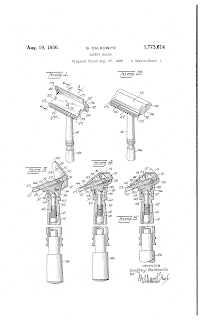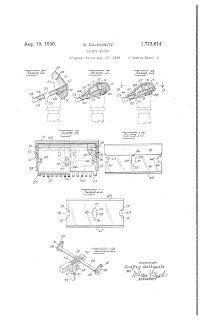As I was poking around for information on a different razor, I stumbled over the abbreviated history of the Diamond Edge Razor, as made by the Norvell-Shapleigh Hardware Co – later the Shapleight Hardware – in St Louis, Missouri, between 1910 and 1919. Described in Waits’ Compendium as a single edge hoe style razor with a closed comb guard, it apparently was offered in a number of different styles; the DE100 was silver plated in green lined box, the DE200 had red lining and gold plated tips, the DE300 had gold plated frame with gold and silver plated handle in an imitation pigskin case, while the top model – the DE400 – was all gold plated, came in a gold plated box with it’s own stropper.
As can be guessed by the fact that you got a stropper with the high end kit, the Diamond Edge wasn’t meant to use disposable blades – rather reusable ones. All models seems to have been delivered with a holder for the blade to make them easier to strop, so even if replacement blades were available,1 it seems the idea was to buy a razor with enough blades to last practically forever.
The patent for the Diamond Edge was filed by Carl Gustav Schimkat in the beginning of 1906 – so before Gillette had emerged as the top dog in the safety razor market. The Diamond Edge was one of several fairly successful competitors to the Gillette, in what was a fairly fluid marketplace. The patent itself isn’t too earth-shattering in hindsight, like many others it aimed to
…produce a simple and inexpensive safety razor…
From patent US866969A
Simple and inexpensive meant that one could tap into a large marked; people who would like to be clean shaven, but who couldn’t afford an expensive razor or frequent visits to the barber.
An interesting element of the razor was that the blade wasn’t held by the razor directly, but by a retainer (12) that helped give the blade the required rigidity – which make sense considering the design of the razor was very close to the Kampfe wedge razor design in concept if not in execution.

It seems like the success of the Gillette during and after the Great War killed off the Diamond edge… it is hard to compete with a razor all the doughboys got for free while in the service after all. Those who owned them probably used them while blades could be gotten, but today the Diamond Edge and other single edge hoe style razors seems to have been all but forgotten.. what little we can easily find and use today is vintage EverReady and GEM style razors.
For those interested, the whole patent can be read at Google Patents and razors.click.
1) Clark’s Blade & Razor Co, operating out of Newark, NJ, offered off-brand blades via the Sears Catalogue for a wide range of razors until at least the end of the 1920’s. Their No3 blade is advertised as fitting the Diamond Edge as well as Auto Strop, Young and other razors.











